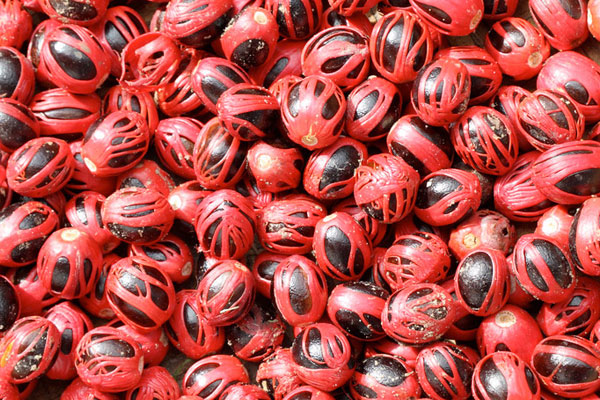Introduction
Taxonomy
Family - Myristicaceae
Species - Myristica Fragrans
General Description
Nutmeg (Myristica fragrans) is native of Moluccas in East Indonesia. It has been reported that the plants have been introduced into Sri Lanka in the beginning of nineteenth century.
Nutmeg plant is a spreading evergreen tree reaches up to 15-20 m height. The leaves are alternate, dark green, pinnatinerved. Flowers are generally unisexual and dioecious. However, bisexual flowers of varying sexual composition can also be found. Occasional trees with male and female flowers are also seen in the plantations. Fruits are fleshy drupes, broadly pyriform, drooping with a circumferential longitudinal ridge. Fruit colour turns into yellow during the ripening and the pericarp splits into 2 halves exposing purplish-brown, shiny seed surrounded by a net like red aril. Indonesia, Grenada, Sri Lanka, Trinidad, China and India are the major countries producing nutmeg and mace. The world trade of these two spices is in the range of 8,000-10,000 MT.
Nutmeg tree yield two spices, nutmeg, which is the kernel of the seed and mace, which is the net-like crimson colored leathery out growth (aril) covering the shell of the seed.

Cultivation
Agronomic Requirements for cultivation
Deep, well drained, loam and sandy clay loam soils rich in organic matter are preferable. Soils with high water-table or liable to water logging are unsuitable.
Plant requires well distributed rainfall of 1,500-2,500 mm. In areas with a pronounced dry spell or sandy soils, the annual rainfall should be higher. The annual average temperature should be 20-30°C without much seasonal or diurnal variation. Persistent strong winds are harmful for the growth of plant. Sheltered valleys and leeward slopes are suitable for cultivate nutmeg.
Plant can be grown at elevation up to about 600m in the wet zone. Shade is essential during the first 2-3 years of growth. Thereafter full exposure to sunlight is beneficial.
Recommended Varieties
In Sri Lanka there are no special varieties of nutmeg. However, as usual method of propagation is by seeds, and these seeds should be taken from selected mother trees, for high yields, large nuts and heavy mace. Seeds have to be sown as soon as possible since viability is lost in 8 to 10 days.
Field Planting and Spacing
The seedlings are field planted at the beginning of the rainy season. In Nutmeg, there are separate male and female trees but the sex of the trees can be identified only after flowering. In general, about 50% of seedlings will be males. Therefore, the initial spacing may be about 6 m x 6 m and after flowering, they may be thinned out. Male trees do not fruit but are essential for pollination, for which 1 male to 10 female trees is adequate.

